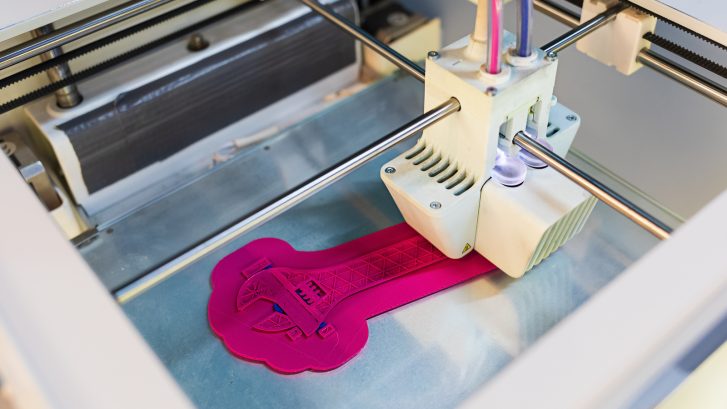How 3D Printing Has Mapped Medical Breakthroughs of the Recent Past, Present, and Fascinating Future
3D printing technology charts the horizon of medical science at its most innovative, but the process has roots in surgical procedures from centuries past. Hip replacements were performed as far back as 1891, when a German doctor used ivory to replace the head of a human femur. Dental implants date back even further, but the source of the tooth donors was shrouded in mystery. The common myth purported that patients were receiving teeth pulled from brave soldiers who perished on the field of battle, but the truth was that dentists were just harvesting them from cadavers at the local morgue.
Fast forward to the digital age. The first successful 3D-print assisted reconstructive surgery was performed in the Netherlands during the summer of 2011. The 83-year-old patient suffered from a chronic infection in her skeletal system, adversely affecting the strength of her jawbones. Given the woman’s advanced age, surgeons needed to exercise the utmost sensitivity; traditional implants would have been too cumbersome for her fragile frame.
Enter the 3D Printer
Using titanium powder, the laser-guided printer fused together thousands of layers of the alloy to create a jaw that emulated the subject’s original facial structure. Each millimeter of her new jaw’s height required 33 layers of titanium – a painstaking process indeed. But the result was a true breakthrough. It featured a bio-ceramic coating and articulated joints with a network of grooves and cavities that would facilitate ideal muscle attachment and foster the healthy growth of veins and nerves.
The operation was a resounding success. The patient was home four days later. Her new jaw weighed only about 30% more than her organic jaw; not bad for the first metallic model ever implanted.
Since that inaugural effort six years ago, 3D printing and medical technology have evolved exponentially. As with any successful endeavor, surgeons must pinpoint the challenges and counter them with opportunities. Face transplantations are complex procedures that entail a myriad of complications. The patient in need has already suffered facial tissue loss due to an accident or a disease; countering the damage involves an extremely delicate process that requires vascular reconstruction to preserve and replenish as much of the subject’s tissue as possible. The main obstacle is that this procedure demands the patient’s blood flow to be halted while the reconnections occur.
This process must be expedited, or the consequences could be lethal.
3D printing allows the majority of the work to be done BEFORE surgery. A scan of the subject’s skull and facial bones is uploaded to the computer to create a 3D model; surgeons can use this model as a detailed reference guide. If they fully understand their endpoint, it’s much faster to get there. This reduces surgery time and increases the patient’s chances of survival. While the average facial transplant procedure takes up to 25 hours, the vascular reconstruction process alone takes 60 minutes.
Now let’s look at that same surgery from the patient’s point of view. Medical advances are all well and good for the doctors performing facial transplants, but what about the recipient of the services? The main concern is very intimate and aesthetic: What will I look like after it’s completed? The answer is only limited by the technology at hand. 3D scanning innovation advances every microsecond; present and future subjects of facial transplantation are benefiting from every upgrade to the software. But the diagnosis for the reliability and reproducibility of 3D printers is still inconclusive.
Some patients, however, don’t have time to wait for science to catch up to their urgent health demands. Such is the case with a 12-year-old Chinese boy whose spinal cord was threatened by a malignant tumor. Doctors at Peking University had to act fast, so they turned to 3D printing technology to assist them in saving the lad’s life. Surgeons were able to remove the affected vertebra and replicate it with their 3D scanner. They created and printed a replacement bone out of titanium powder, but this presented a new challenge: how would they safely implant it in their young patient’s spine? The answer: craft tiny pores in the 3D printed vertebra so the surrounding bones could fuse and grow with it as the boy progresses through adolescence.
The future presents an even more fascinating menu of possibilities. While most current 3D printed structures are designed to replace skeletal body parts, medical experts are formulating theories to transplant synthetic organs into their patients. One glimpse at donor lists across the country (and the world) verify that the demand is great, but what about the supply? Surgeons can’t simply craft a kidney out of metallic powder; they would require organic materials for the organ to function properly. This would necessitate sampling a small amount of the patient’s healthy tissue and multiplying it in a lab.
How long would this process take? Would the host reject its artificially grown organ? Who is willing to be the first patient to submit to such experimentation? These questions pave the way to a 3D printed path toward medical progress and the future of healthcare.
To learn more about the benefits of reconstructive facial surgery using the latest in 3D printing technology, please contact us today. We are happy to discuss the details and procedure in more detail at your convenience.

